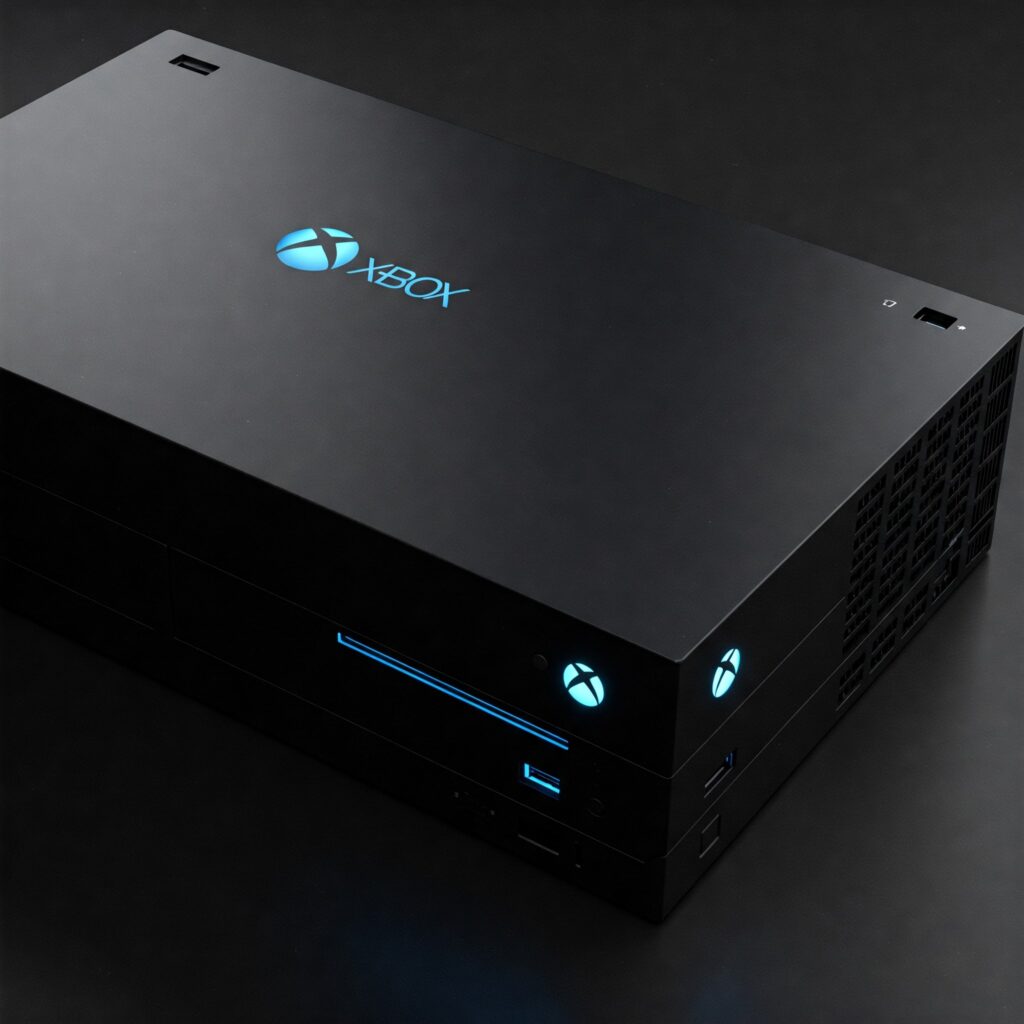Please remember we’re looking quite far into the future here, with the next Xbox generation likely targeting a late 2027 or 2028 arrival at the earliest. While grounded in current technological trends and industry whispers, this deep dive remains purely speculative. It’s fun to anticipate the potential advancements and dreaming & PREPARE for future possibilities! Just as we’re going to explore the potential future for Xbox here, since we also previously put together a similar speculative write-up exploring what Sony’s PlayStation 6 might have in store for us too.
While the Xbox Series X/S brought power and the velocity of Game Pass to the forefront, the real game-changer from Microsoft is still on the horizon. Forget thinking about just a new box arriving around late 2027 or 2028. We’re forecasting the next phase of Xbox as a deeply integrated gaming ecosystem, powered by intelligent hardware, amplified by the cloud, and designed to deliver unparalleled access and choice.
What Will They Call It? (Pure Speculation!)
Before diving in, let’s do what we always do first. What name resonates with this future vision?
- Xbox Infinite: Emphasizing the boundless potential of cloud and Game Pass.
- Xbox Nexus: Highlighting its role as the central hub of your gaming universe.
- Xbox Series Z (or Omega): Signifying the ultimate iteration.
- Xbox Continuum: Focusing on seamless play across devices.
- Xbox Synapse: Leaning into the AI/neural network integration.
- Xbox Stratos: Pointing towards cloud dominance.
Okay, back to the analysis…
The “5” Pillars of Next-Gen Xbox: Performance, Intelligence, Access, EcoSystem & Empowerment
Raw Performance & Next-Gen Fidelity:
-
Under the Hood: Building the Next-Gen Behemoth
Whispers from the supply chain and strategic hires point towards another deep collaboration with AMD, pushing silicon further than ever:
- CPU/GPU Evolution: We’re likely looking at AMD’s Zen 5 or even Zen 6 CPU architecture paired with next-gen RDNA graphics (RDNA 4 or 5). Forget just hitting 4K/60 consistently; the target here will likely be rock-solid high frame rates (120fps+) at 4K, with 8K becoming a viable target for many titles. The raw power jump needs to be significant enough to feel like a true generational leap, delivering visuals that make you question reality – think the detail and scope hinted at in tech demos, finally realized in real-time gameplay.
- Memory & Storage: Banishing Bottlenecks: Faster RAM (GDDR7 maybe?) and next-gen NVMe SSDs are practically a given. The goal? Obliterating loading screens entirely, not just shortening them. Combine this with potentially larger storage options (2TB+ standard?) to handle increasingly massive game sizes.
Insight: This level of performance isn’t just for prettier pixels; it unlocks the potential for fundamentally more complex game simulations, larger, more dynamic open worlds without loading hitches, and advanced physics systems previously unthinkable on console hardware.
- Backward Compatibility Commitment:
Expect continued commitment to robust backward compatibility, ensuring your digital library moves forward. This isn’t just a feature; it’s a cornerstone that builds significant consumer trust and ensures players don’t lose their digital investments when upgrading hardware. Hint: Look for potential for next-gen enhancements applied automatically to even more older titles, potentially going beyond the current FPS Boost/Auto HDR system with more sophisticated AI-driven improvements.
Pervasive AI & Embedded Intelligence:
- The AI Advantage (DirectSR Explained): This is where the “smarts” truly differentiate. AI integration, likely featuring dedicated silicon or vastly enhanced GPU compute units, is critical. Technologies like Microsoft’s DirectSR (Direct Super Resolution) are key. Why? They allow the console to achieve that holy grail: rendering demanding visuals at high target resolutions (think crisp 4K or emerging 8K) while alsomaintaining incredibly high and stable frame rates. Instead of brute-forcing every single pixel natively which consumes massive resources, AI intelligently reconstructs or generates frames, giving you that ultra-high-res, high-framerate look without the crippling performance cost. While competitors like NVIDIA (DLSS) and AMD (FSR) offer similar upscaling, hint: expect Microsoft to leverage its broader AI research and deep Azure integration for unique optimizations, potentially even learning user preferences for visual quality vs. performance trade-offs.
- AI Beyond Graphics: Expect AI to also power hyper-realistic NPCs (think beyond scripts, towards characters with memory and believable behavior like those hinted at in Blade Runner), dynamic environments that react intelligently to players, lightning-fast asset loading by predicting player needs, and perhaps even AI assisting in procedural content generation for near-infinite replayability or smarter, fairer matchmaking systems. Insight: Microsoft’s heavy investment in AI tools for developers (like GitHub Copilot) could also streamline complex game development.
Unmatched Access & Player Choice (Game Pass + Cloud):
- The Ecosystem Engine (Game Pass): Game Pass remains central, likely expanding and evolving. It’s positioned as the core value proposition, guaranteeing access to all Microsoft first-party titles day one. The console is the premium native gateway, but enhanced xCloud (Xbox Cloud Gaming) aims for near-latency-free streaming, making your library accessible instantly across PCs, mobile devices, smart TVs, and potential dedicated Xbox handhelds. Imagine accessing your entire compatible library, instantly, like stepping into The Matrix’s construct program. Hint: Could we see new Game Pass tiers emerge, perhaps bundling cloud handheld access or offering unique cloud-native perks? A potential handheld itself might aim higher than just streaming, possibly targeting impressive native performance (think optimized Series S-level) for true gaming on the go.
- Cloud-Hybrid Gaming Powered by Azure: This is a truly Xbox-associated potential leap, leveraging Microsoft’s massive cloud infrastructure. Games could dynamically offload complex calculations – think city-scale physics simulations involving thousands of objects, advanced global AI systems managing continent-sized worlds, or complex ray-tracing calculations for global illumination – seamlessly to Microsoft’s powerful Azure cloud servers. This blends local and cloud processing for experiences far richer and more dynamic than local hardware could ever manage alone. Insight: This unlocks potential for truly persistent MMO worlds that evolve even when you’re offline, battle royales scaling to unprecedented player counts, or environmental detail and destruction physics far exceeding local rendering capabilities. Tip: The viability of these experiences heavily relies on low-latency, high-bandwidth connections; and w/ Wi-Fi 7, Bluetooth, Cable/Ethernet handoffs, and 6G are all advancing and will eventually provide us with faster speeds, lower latency, and more reliable digital experiences.
Deep Ecosystem Synergy (Beyond Gaming):
- The Microsoft Advantage: This pillar extends beyond just gaming hardware, leveraging the full breadth of the Microsoft ecosystem. Expect even tighter integration with the Windows PC ecosystem, imagining more unified storefronts, shared features, seamless game state/settings syncing, and perhaps optimized ways to interact (like easier cross-device peripheral use).
- Broader Connections: But the synergy could run deeper, potentially leveraging Azure not just for game processing but for robust profile management and cloud services. Platforms like Microsoft Mesh could enable shared AR/VR social spaces intrinsically linked to your Xbox profile and games. Insight: Your Microsoft Account becomes the absolute central key, the passport enabling fluid transitions and a unified identity across potentially disparate Microsoft experiences – from your console to your PC, maybe even interacting with aspects of Teams or other productivity tools via shared avatar systems or social layers. This is Microsoft’s strategic moat – embedding gaming within its vast productivity and cloud empire.
Developer Empowerment & Content Velocity:
- Fueling the Pipeline: Crucial to keeping Game Pass valuable is a steady stream of high-quality content. Microsoft is heavily investing in empowering developers (especially their growing roster of first-party studios) with cutting-edge tools built upon the latest DirectX advancements, Azure cloud infrastructure(like Game Dev VMs & Azure Cognitive Services), PlayFab backend services, and integrated AI assistance(potentially integrating tools like GitHub Copilot directly into workflows).
- Enabling Next-Gen Experiences: This allows studios to build next-generation experiences more efficiently and create games specifically designed to leverage the Xbox ecosystem’s unique strengths, such as cloud-hybrid models or pervasive AI features. Insight: Faster, more streamlined development cycles, aided by smarter tools tailored to the platform, mean a steadier velocity of diverse, high-quality content hitting Game Pass. Hint: Expect more “only possible on the Xbox ecosystem” announcements, highlighting unique gameplay mechanics enabled by these Azure and AI development capabilities, serving as key differentiators.
This generation focuses on removing friction: near-invisible loading, stable high frame rates becoming the norm thanks to AI, and the ability to play your games wherever you prefer – premium fidelity on the console, convenient access via the cloud.
Future Tech Integration:
Here’s where things get really exciting, leaning into Microsoft’s unique strengths:
- Advanced Cloud Streaming & Azure Synergy: Beyond just faster streaming, think cloud-native features powered by Azure. This includes the hybrid processing mentioned earlier, but also potentially cloud-based physics, AI routines, or even entire game worlds rendered dynamically in the cloud, streamed flawlessly to your device. Imagine MMOs with the scale, persistence, and instant accessibility of Ready Player One’s Oasis, always evolving, or accessing complex simulations as readily as stepping into The Matrix.
- Microsoft Mesh & Mixed Reality Integration: Leveraging platforms like Microsoft Mesh, expect deeper integration with AR and VR. This could mean shared social spaces linked to games, holographic game elements appearing in your room via AR glasses (perhaps future HoloLens successors or partners) like data streams in Minority Report, or interacting with 3D maps and schematics like Tony Stark in Iron Man.
- AI Beyond Graphics: AI won’t just upscale pixels. Expect AI-driven NPCs with real long-term memory and adaptive behavior, potentially approaching the unsettling realism of hosts in Westworld or the artificial consciousness explored in Blade Runner 2049. Imagine AI-powered game mastering adapting stories on the fly, real-time language translationbreaking down global barriers like a Star Trek Universal Translator, or a sophisticated personalization AI tailoring your experience like Samantha in Her.
- Deeper Windows & Ecosystem Integration: Moving beyond basic cross-play. Think seamless continuity between console and PC – a unified digital experience where your games, progress, and identity flow effortlessly across devices, perhaps less cinematically flashy but fundamental to a smooth user experience.
- Next-Generation Networking & QoS: Beyond just raw speed (like 6G), expect intelligent network optimizationbuilt into the Xbox network and Azure. While hard to visualize, this aims for the feeling of near-zero latency needed for the instantaneous reactions in Top Gun: Maverick’s dogfights or the flawless information flow required in The Matrix, making lag a true relic of the past for online and cloud gaming.
- Evolved Digital Avatars & Identity: A significant upgrade to Xbox avatars, making them more expressive, customizable, and portable across the Microsoft ecosystem – your digital self becoming as central to your online identity as the personalized avatars within Ready Player One’s Oasis, usable across games, social VR via Mesh, and potentially even professional contexts.
- Advanced Haptics & Sensorial Input: While Sony pushed haptics forward, expect Microsoft to respond. This could mean more nuanced controller feedback, but also potentially exploring camera-based input (a Kinect successor?) for gesture control that echoes the intuitive hand movements seen in Minority Report, adding another layer of interaction beyond buttons and sticks.
- Sustainable & Efficient Gaming Tech: Increasing focus on power efficiency. Expect intelligent power management modes, potentially optimizing performance based on gameplay demands or even offloading tasks to the cloud during non-critical moments to reduce local energy consumption, aligning with broader environmental goals. (This one is more practical than cinematic!)
The Analyst Takeaway & Side-by-Side Summary of upcoming PS6 and XBOX:
Microsoft’s next push isn’t just a hardware cycle refresh; it’s the culmination of their ecosystem strategy. They’re building an intelligent, flexible platform defined by choice, cloud power, and the undeniable value of Game Pass. The console itself will be a powerhouse built on advanced AMD silicon, but its true strength lies in being the heart of a much larger, interconnected gaming universe amplified by AI and Azure. Look towards late 2027/2028 for Microsoft to make its next big move, aiming to change not just how powerful games are, but how accessible, intelligent, and integrated they become.
Potential PS6 “Big Tech” Focus:
- CPU/GPU: Likely custom next-gen AMD silicon (Zen 5/6 CPU & RDNA 4/5-based GPU) potentially prioritizing peak native rendering performance and throughput.
- AI Upscaling/Enhancement: Advanced, proprietary PSSR (PlayStation Spectral Super Resolution), potentially deeply integrated into the silicon for efficient high-resolution/high-framerate gaming.
- Memory Subsystem: High bandwidth focus, possibly utilizing next-gen tech like GDDR7 RAM.
- Immersion Hardware: Likely evolution of the DualSense controller (advanced haptics, adaptive triggers) and continued focus on 3D Audio hardware/software integration.
- Cloud Approach: Enhanced cloud streaming via PlayStation Plus, but likely less emphasis speculated on hybrid cloud processing integrating Azure-like capabilities for core game logic/simulation compared to Xbox.
Potential Next Xbox “Big Tech” Focus:
- CPU/GPU: Likely custom next-gen AMD silicon (Zen 5/6 CPU & RDNA 4/5-based GPU) with similar performance goals, but potentially with a stronger emphasis on AI silicon synergy and efficiency.
- AI Upscaling/Enhancement: DirectSR leveraging Microsoft’s broader AI research and potential Azure cloud optimizations for efficient high-resolution/high-framerate gaming.
- Cloud Integration (Azure): Major strategic focus on Cloud-Hybrid Processing, allowing games to offload complex tasks (AI, physics, world simulation) to Azure, potentially enabling unique scale and complexity not achievable purely locally. Advanced xCloud streaming is core.
- Storage Technology: Emphasis likely on pushing NVMe SSD speeds (e.g., Gen 5) to further minimize loading and enable rapid asset streaming.
- Ecosystem Integration Tech: Deep technical hooks for seamless Windows PC synergy, platform-level support for cloud-aware experiences across devices (console, PC, potential handhelds).



